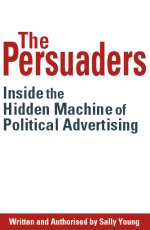 Sally Young — The Persuaders: Inside the Hidden Machine of Political Advertising
Sally Young — The Persuaders: Inside the Hidden Machine of Political Advertising
Pluto Press, Sydney, 2004
ISBN: 186403 304 5
As an advertising writer who has occasionally had a brush with political advertising (ALP in the early 1980s, Liberal in the late 1980s and ALP again in the 1990s and 2000s), I enjoyed Sally Young’s perceptive and extremely well-researched look at this particularly murky part of the advertising industry.
Refreshingly for an academic, Young understands how advertisements actually work and does not approach her subject in an excessively doctrinaire or ideological fashion. There are many things she does exceedingly effectively. I could not fault her analysis of many of the notorious political advertisements of the past, from “Its Time” to “Whingeing Wendy”. She has talked to the right people and knows how the advertising industry and our political system interact. I agreed with all of the 18 recommendations she makes for reforming our out-of-control political advertising system, though I suspect (as does Young) that asking politicians to reform political advertising is a bit like asking them to manage their own remuneration – ultimately futile.
I also enjoyed her analysis of the conundrum at the heart of a democracy in the age of mass media; that the nature of freedom of speech is fundamentally changed when you move from the town hall meeting, or political pamphlet (however rabble-rousing) to the 30 second commercial, whether viewed on an old fashioned television set or via the internet. As she makes clear, political advertisements work on our emotions, they do not really make much use of facts. This is not a criticism, however, though Young may mean it to be one. It is merely an acknowledgment of reality. After twenty five years in the advertising industry, I have learnt two very important things about persuasion. The first is that all purchase decisions (and a vote, unfortunately, is just another purchase decision) are made emotionally and then post-rationalised, and it’s the post rationalising we mostly hear in focus groups. The second is that television is an emotional medium. If you want to tell people facts, put them in a long copy print advertisement or on the web, but even then, only the political junkies are likely to read them. In an information-drenched age, it is an uncomfortable truth that people put most of their energy into screening out messages, and that’s why the emotional grab has become so ubiquitous.
Worse, as Young understands, advertising has two very different effects. The first is the effect each individual advertisement has – whether political or purely commercial. The other is the cumulative effect all advertisements have. In the case of political advertising, advertisements that were individually effective, like the two mentioned above, have also inadvertently helped undermine the public’s faith in politics and politicians as a whole.
In fact, Young connects the fact that all politicians are now pretty much on the nose (an effect of our long term exposure to political advertising in itself) to the fact that the practitioners of political advertising now prefer to knock their opponents rather than praise their own candidates – what’s called “negative” political advertising. Her point is that any mention of a politician in a television advertisement is now negative, so you may as well only mention the guy you want to beat and sling a bit more mud at him while you are at it.
This is, in fact, where political advertising parts company with its commercial cousins. When you are selling a commercially available product or service, the emphasis is always on accentuating the positive (sometimes to a ridiculous extent), and advertisements which knock a competitor have almost disappeared from existence. I could pretend this is because commercial advertising is much nicer than its political counterpart, but, as Young points out, it is actually because the laws governing commercial advertising are so much more stringent. Regular advertising is subject to The Trade Practices Act, claims cannot be made that cannot be substantiated. Corporations are extremely wary of making any dodgy claims, not because the public or even the regulators will jump on them but because they know their competitors will. One of the most chilling parts of Young’s exposé is when she reveals the paucity of rules that govern political advertising, techniques can be used, claims made and the truth stretched in ways that are simply impossible in ordinary advertising. Sometimes one or other of the parties objects about some of the more outrageous examples of political advertisements, but mostly they do not, knowing full well, I suppose, just how much use of similar tactics they make themselves.
All in all, Young’s thesis is well made. There really does need to be a wholesale reformation of political advertising in Australia. We need to examine the way it is funded, spending caps, the way political incumbents use public money to fund thinly disguised “informative ads” about government initiatives around election time, how it is policed, and the effect it is having on our increasingly compromised democratic process. Quite frankly, should we have political advertising at all? With the advent of even dirtier tactics like push polling and the shonky technique of paying people to “play” ordinary people in public places spouting both commercial and political messages, I agree with Young. It is time to take another look at the free-for-all we allow our politicians.
Jane Caro is a lecturer in Advertising at the University of Western Sydney

